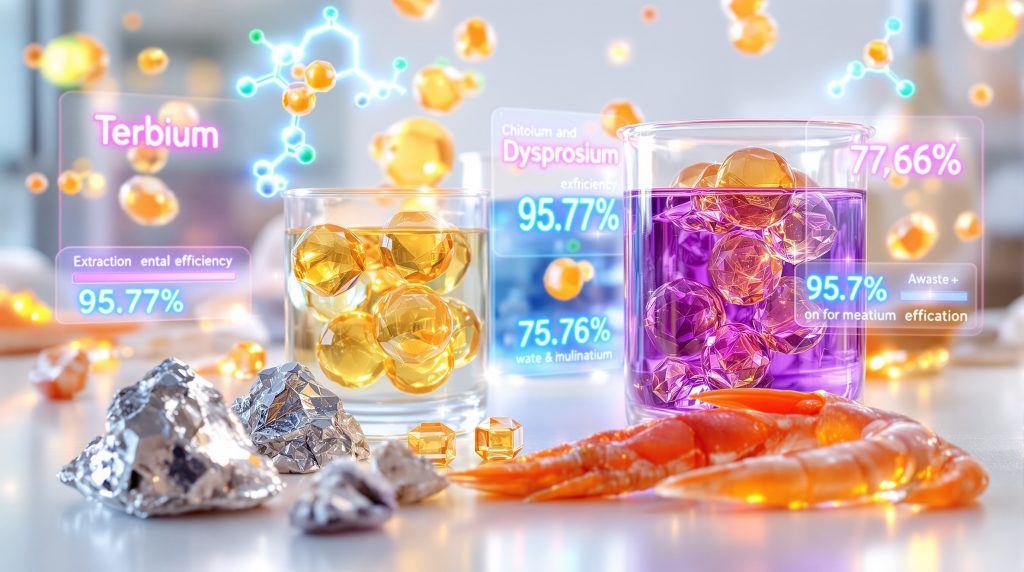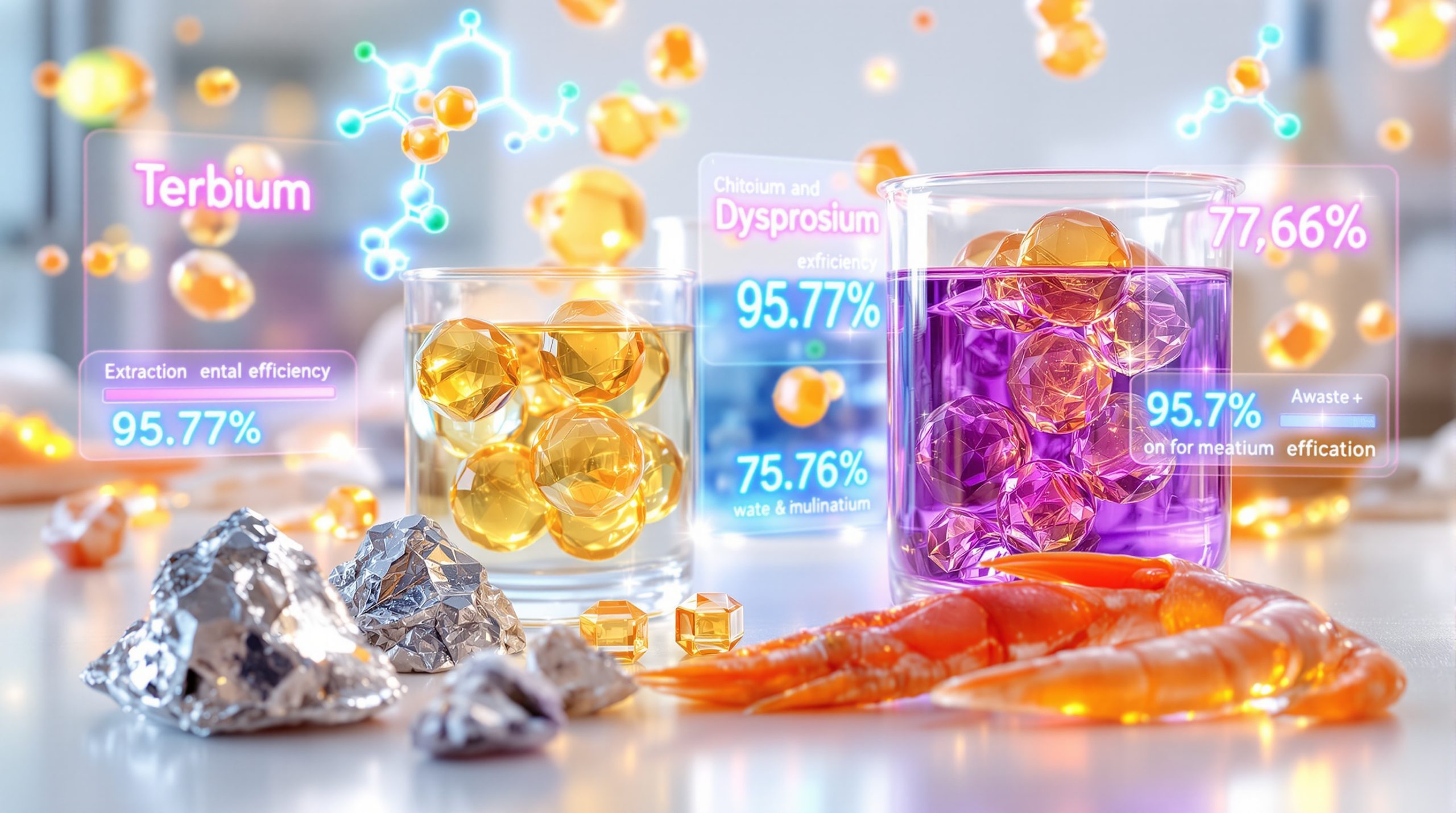Understanding Bio-Based Extraction Innovation
Chitosan-based hydrogels for rare earth extraction represent a groundbreaking shift toward sustainable resource recovery methods that could fundamentally alter global supply dynamics. These advanced polymer networks, derived from crustacean shells that would otherwise become waste, offer an environmentally responsible alternative to conventional solvent-intensive extraction processes. The technology addresses mounting pressure for cleaner mining industry innovation while potentially creating new pathways to access critical materials.
The strategic importance of developing alternative extraction methods has intensified as global demand for heavy rare earth elements continues to surge. Electric vehicle manufacturing, renewable energy systems, and advanced defence technologies all depend on consistent access to these materials, yet current supply chains remain concentrated in a handful of processing facilities. Chitosan hydrogels present a bridge between environmental stewardship and resource security, offering the possibility of recovering valuable elements from previously unusable waste streams.
Chitosan's Molecular Foundation
The effectiveness of chitosan-based hydrogels stems from their unique polymer structure, which contains abundant amino and hydroxyl functional groups capable of forming strong coordinate bonds with rare earth ions. This biopolymer, extracted from the shells of crabs and shrimp, transforms what was once seafood industry waste into a sophisticated extraction material. The molecular architecture allows for precise control over binding site geometry and selectivity.
Recent research by scientists at the Missouri Water Center has demonstrated that these materials can achieve exceptional sorption capacities of up to 162.53 mg/g for terbium and 132.05 mg/g for dysprosium. Unlike synthetic alternatives that may require energy-intensive manufacturing processes, chitosan utilises renewable waste materials as feedstock, creating a circular economy approach to critical material recovery.
The biocompatibility advantages extend beyond environmental considerations to practical operational benefits. Traditional synthetic sorbents often require specialised handling protocols and generate hazardous disposal streams. Chitosan hydrogels, being derived from natural sources, offer inherently safer processing conditions and simplified waste management procedures.
Selective Metal Binding Mechanisms
Ion-Imprinting Technology Framework
The core innovation in chitosan-based hydrogels for rare earth extraction lies in ion-imprinting technology, which creates molecular recognition sites specifically shaped for target elements. During synthesis, the hydrogel is imprinted with either dysprosium or terbium ions, forming three-dimensional binding cavities that complement the ionic radius, charge density, and coordination preferences of these specific metals.
This molecular templating approach produces what researchers describe as chemical locks designed for particular keys. When the imprinted hydrogel encounters a solution containing multiple metal ions, it demonstrates preferential binding to the target element over competing species. Field testing has confirmed this selectivity maintains effectiveness even in complex mine drainage containing iron, aluminium, copper, and other interfering metals.
The crosslinking mechanism enhances both material stability and binding selectivity through controlled polymer network formation. Two distinct crosslinker formulations enable pH-specific optimisation: AUCH-D systems utilise 1,2,7,8-diepoxyoctane for acidic environments, while AUCH-G systems employ glutaraldehyde for alkaline conditions.
Dual-Environment Processing Capability
Mining operations generate waste streams across a wide pH spectrum, from acidic drainage to alkaline tailings, creating challenges for single-parameter extraction systems. The dual-pathway chitosan hydrogel approach addresses this reality by providing optimised materials for different chemical environments without requiring extensive pre-treatment.
AUCH-D Performance Characteristics:
- Optimal pH range: Around 4 (acidic conditions)
- Terbium removal: 95.77% in field trials
- Dysprosium recovery: Approximately 73% in acidic drainage
- Application: Mining operations with naturally acidic water chemistry
AUCH-G Performance Characteristics:
- Optimal pH range: Around 8 (mildly alkaline conditions)
- Dysprosium removal: 78.06% in field trials
- Terbium recovery: Approximately 67% in alkaline tailings
- Application: Processing facilities with alkaline waste streams
This pH-responsive behaviour eliminates the need for costly chemical adjustment of mine water before processing, reducing both operational expenses and environmental compliance burdens. The technology adapts to existing conditions rather than forcing all materials through uniform pre-treatment protocols.
Chemical Bonding and Kinetic Behaviour
Laboratory analysis confirms that chitosan hydrogels achieve true chemisorption rather than weak physisorption, indicating strong chemical bonds between rare earth ions and the polymer matrix. Experimental data fitting Langmuir isotherms demonstrates monolayer coverage with predictable maximum capacity limits, while pseudo-second-order kinetics confirm that binding is chemically controlled rather than diffusion-limited.
The chemisorption mechanism provides operational advantages for industrial applications. Unlike physisorption, which relies on weak van der Waals forces that can be disrupted by minor environmental changes, chemical bonding ensures that captured metals remain bound under normal processing conditions. Temperature studies across 25-65°C ranges have validated the thermal stability of these chemical interactions.
Kinetic modelling reveals that equilibrium is achieved within timeframes suitable for batch industrial processing, suggesting compatibility with existing mineral processing infrastructure. The pseudo-second-order rate behaviour indicates that binding capacity is proportional to the square of available binding sites, providing predictable scaling relationships for facility design.
Element-Specific Recovery Performance
Heavy Rare Earth Selectivity Patterns
The most significant discovery in chitosan hydrogel development is the demonstrated selectivity for heavy rare earth elements, particularly dysprosium and terbium, over more abundant light rare earth elements. Furthermore, this selectivity addresses one of the most challenging aspects of rare earth processing: separating high-value heavy elements from the more common light elements that typically dominate ore compositions.
| Element | Maximum Capacity (mg/g) | Acidic Removal (%) | Alkaline Removal (%) | Selectivity Level |
|---|---|---|---|---|
| Terbium | 162.53 | 95.77 | 67 | High |
| Dysprosium | 132.05 | 73 | 78.06 | High |
| Lanthanum | Variable | Significantly Lower | Significantly Lower | Moderate |
| Samarium | Not Specified | Lower | Lower | Low |
| Europium | Not Specified | Lower | Lower | Low |
The inverse performance relationship between terbium and dysprosium across different pH regimes validates the dual-hydrogel approach. Terbium achieves superior recovery in acidic conditions while dysprosium performs better in alkaline environments, suggesting that optimisation for specific operating conditions can maximise overall recovery efficiency.
Competitive Binding Studies
Real-world mining environments contain complex mixtures of dissolved metals that can interfere with selective extraction processes. Chitosan hydrogels have demonstrated remarkable selectivity maintenance even when competing ions are present in solution. Testing with lanthanum, samarium, and europium confirmed that target elements maintain preferential binding despite the presence of chemically similar competitors.
The Pea Ridge iron-rare earth deposit in Missouri provided field validation data under actual mining conditions. Unlike laboratory studies using pure solutions, field trials involved complex water chemistry including:
- Multiple rare earth elements at varying concentrations
- Base metals (iron, aluminium, copper) acting as potential interferents
- Dissolved sulfates and other mining-related chemical species
- Natural pH variations across different discharge points
- Seasonal concentration fluctuations
Despite this chemical complexity, the hydrogels maintained strong selectivity for dysprosium and terbium, confirming that the ion-imprinting approach creates robust molecular recognition that persists in challenging environments. Moreover, this sustainable mining transformation demonstrates the potential for environmentally responsible extraction methods.
Temperature and Regeneration Optimisation
Industrial viability requires materials that can withstand repeated use cycles while maintaining consistent performance. Chitosan hydrogels have demonstrated greater than 70% capacity retention after five complete regeneration cycles, indicating potential for extended operational life in commercial applications.
Regeneration Process Benefits:
- Desorption protocols allow metal recovery for downstream processing
- Hydrogel materials can be reused multiple times before replacement
- Reduced waste generation compared to single-use extraction methods
- Economic advantages through material lifecycle extension
Temperature optimisation studies across the 25-65°C range have identified optimal operating conditions for different processing scenarios. Higher temperatures generally improve kinetic rates but must be balanced against energy costs and material degradation considerations. The data suggests that moderate temperature operation provides the best combination of extraction efficiency and material longevity.
Advantages Over Conventional Methods
Environmental Impact Reduction
Traditional rare earth separation relies heavily on solvent extraction processes that consume large volumes of organic chemicals and generate substantial hazardous waste streams. Chitosan-based hydrogels for rare earth extraction eliminate the need for organic solvents entirely, operating in aqueous environments that dramatically reduce environmental compliance requirements.
The water-based processing approach addresses several critical environmental concerns:
- Solvent elimination: No organic chemical consumption or disposal requirements
- Reduced toxicity: Biocompatible materials minimise worker safety risks
- Simplified waste streams: Aqueous solutions rather than mixed organic/aqueous phases
- Lower carbon footprint: Reduced energy requirements for solvent recovery and recycling
Chitosan production from crustacean waste creates additional environmental benefits by diverting material that would otherwise require disposal. The seafood industry generates millions of tons of shell waste annually, much of which currently goes to landfills or low-value applications. Converting this waste into high-performance extraction materials represents a genuine circular economy application.
Economic Viability Analysis
Cost-effectiveness analysis must consider both direct material costs and broader economic factors including waste disposal, environmental compliance, and operational complexity. While chitosan hydrogels may require higher initial capital investment for specialised equipment, they offer several economic advantages over traditional methods:
Cost Reduction Factors:
- Elimination of expensive organic solvent purchases
- Reduced hazardous waste disposal fees
- Lower environmental compliance costs
- Simplified processing equipment requirements
- Multi-cycle material reusability
Investment Considerations:
- Higher upfront costs for hydrogel synthesis equipment
- Need for specialised personnel training initially
- Potentially lower throughput rates compared to established methods
- Unproven long-term durability in industrial environments
The economic equation becomes more favourable when considering the value of recovered heavy rare earth elements. Dysprosium and terbium command premium prices due to supply constraints and critical applications in high-performance magnets for electric vehicles and wind turbines.
Real-World Mining Applications
Pea Ridge Field Trial Results
The Pea Ridge iron-rare earth deposit in Missouri served as a crucial testing ground for validating chitosan hydrogel performance under actual mining conditions. This site provided access to both acidic drainage and alkaline tailings, allowing comprehensive evaluation of the dual-pathway hydrogel approach across realistic pH ranges.
Acidic Drainage Performance (AUCH-D):
- Terbium removal efficiency: 95.77%
- Dysprosium recovery rate: 73%
- Operating pH: Approximately 4
- Matrix complexity: Multiple competing metal ions present
Alkaline Tailings Performance (AUCH-G):
- Dysprosium removal efficiency: 78.06%
- Terbium recovery rate: 67%
- Operating pH: Approximately 8
- Chemical environment: High dissolved solids content
These field trial results validated laboratory predictions while revealing important practical considerations for industrial deployment. The performance variation between acidic and alkaline conditions confirmed the necessity of pH-optimised hydrogel variants rather than attempting to use a single material across all conditions.
Scaling Challenges and Infrastructure Requirements
Transitioning from successful field trials to commercial-scale operations presents significant technical and logistical challenges. Current testing has focused on batch processing methods using relatively small quantities of hydrogel material, while industrial applications would require continuous flow systems handling thousands of tons of mine water annually.
Technical Scaling Requirements:
- Continuous flow reactor design for large-volume processing
- Automated hydrogel regeneration and metal recovery systems
- Quality control protocols for consistent performance
- Integration with existing mineral processing infrastructure
- Maintenance procedures for extended operation periods
Infrastructure Considerations:
- Capital investment for specialised processing equipment
- Skilled operator training programmes
- Raw material supply chain development for chitosan feedstock
- Waste management protocols for spent hydrogel materials
- Regulatory compliance for new extraction technology
The integration of direct lithium extraction technologies alongside hydrogel systems could create synergistic approaches for multi-element recovery.
Performance Degradation Factors
Real-world operating environments present challenges not fully captured in controlled laboratory studies. Extended exposure to complex mine water chemistry can lead to hydrogel fouling, mechanical degradation, or reduced selectivity over time. Understanding these degradation mechanisms is crucial for predicting long-term operational viability.
Field trials revealed that hydrogel performance varies significantly between laboratory ideal conditions and actual mine water matrices, highlighting the importance of extensive pilot testing before commercial deployment.
Fouling resistance becomes particularly important in mining applications where suspended solids, organic compounds, and biological activity can interfere with extraction processes. The development of anti-fouling surface treatments or cleaning protocols may be necessary for sustained industrial operation.
Current Limitations and Development Needs
Technical Performance Constraints
Despite promising initial results, chitosan-based hydrogels for rare earth extraction face several technical limitations that must be addressed before widespread commercial adoption. Current batch processing methods limit throughput capacity compared to established solvent extraction systems that can handle continuous high-volume streams.
Capacity and Throughput Limitations:
- Batch processing constraints limit material flow rates
- Current hydrogel loading densities may require large reactor volumes
- Mass transfer limitations in thick hydrogel beds
- Extended equilibrium times for complete metal uptake
- Limited data on scaled-up reactor design parameters
Durability and Maintenance Concerns:
- Only five regeneration cycles tested, industrial applications may require hundreds
- Mechanical stability under continuous flow conditions unproven
- Potential for hydrogel degradation from repeated pH cycling
- Fouling susceptibility in complex mine water environments
- Long-term selectivity maintenance requires validation
Economic and Market Barriers
The economic viability of chitosan hydrogel extraction depends heavily on scale, raw material costs, and competition from established technologies. While laboratory results are encouraging, the technology must demonstrate clear economic advantages to justify industry adoption and capital investment.
Cost Structure Uncertainties:
- Raw chitosan material costs at industrial scale
- Energy requirements for hydrogel synthesis and regeneration
- Labour costs for specialised operation and maintenance
- Capital depreciation for unproven equipment designs
- Transportation and logistics for hydrogel distribution
Market Acceptance Challenges:
- Conservative mining industry adoption of new technologies
- Lack of industry standards for bio-based extraction methods
- Uncertainty about product quality compared to conventional separation
- Limited track record for financing and insurance purposes
- Potential intellectual property constraints on commercial use
The implementation of these technologies could significantly contribute to broader mining decarbonisation benefits across the industry.
Regulatory and Standardisation Gaps
The introduction of bio-based extraction technologies into established mining operations requires navigation of complex regulatory frameworks that may not adequately address novel materials and processes. Current environmental permitting procedures are designed around traditional chemical processing methods.
Regulatory Compliance Issues:
- Environmental impact assessment for new bio-based materials
- Worker safety protocols for chitosan handling and processing
- Product quality specifications for recovered rare earth elements
- Waste disposal regulations for spent hydrogel materials
- Water discharge permits for modified processing waste streams
Development of industry standards will be essential for technology commercialisation, providing benchmarks for performance, safety, and environmental compliance that enable widespread adoption and financing.
Global Supply Chain Impact Potential
Strategic Supply Security Implications
The development of chitosan-based hydrogels for rare earth extraction occurs against a backdrop of increasing geopolitical tensions surrounding critical material supply chains. China currently dominates rare earth processing, handling over 80% of global rare earth elements and producing approximately 90% of high-performance rare earth magnets. This concentration creates strategic vulnerabilities for Western manufacturing industries.
Heavy rare earth elements, particularly dysprosium and terbium, represent the most constrained portion of this supply chain. These materials are essential for high-performance permanent magnets used in electric vehicle motors, wind turbine generators, and advanced defence systems. Any disruption to their supply could significantly impact critical technology sectors.
Strategic Advantages of Domestic Recovery:
- Reduced dependency on Chinese processing facilities
- Creation of secondary supply streams from domestic waste
- Enhanced supply chain resilience for critical applications
- Potential for stockpile development from previously unusable sources
- Economic benefits from domestic value-added processing
The technology's impact on critical minerals energy security could prove transformational for national strategic interests.
Infrastructure Integration Possibilities
Successful deployment of chitosan hydrogel extraction technology will require integration with existing mining and processing infrastructure rather than complete replacement of established systems. This approach could accelerate adoption while minimising capital investment requirements.
Integration Pathways:
- Retrofitting existing mineral processing facilities with hydrogel extraction units
- Hybrid systems combining conventional and bio-based separation methods
- Specialised processing of waste streams from established operations
- Mobile processing units for temporary or remote mining operations
- Partnerships between technology developers and established mining companies
The modular nature of hydrogel processing systems may facilitate phased implementation, allowing operators to test and optimise performance before committing to large-scale deployment. This reduces technical and financial risks associated with adopting unproven technology.
Market Size and Investment Implications
The global rare earth elements market continues expanding driven by growth in electric vehicles, renewable energy systems, and advanced electronics. Heavy rare earth elements command premium pricing due to supply constraints, creating attractive economics for recovery technologies that can access previously unusable resources.
Market Growth Drivers:
- Electric vehicle adoption accelerating globally
- Wind energy capacity expansion for renewable targets
- Advanced defence systems requiring high-performance magnets
- Consumer electronics demanding smaller, more efficient motors
- Industrial automation increasing permanent magnet motor demand
Investment timelines for chitosan hydrogel commercialisation will likely span 7-10 years from current research stages to full commercial deployment. This timeline reflects the need for extensive pilot testing, regulatory approval processes, and industrial infrastructure development.
Future Development Pathways
Advanced Materials Science Opportunities
The current generation of chitosan-based hydrogels represents the foundation for more sophisticated materials that could address existing limitations while expanding application possibilities. Research directions focus on improving capacity, selectivity, durability, and operational flexibility.
Next-Generation Material Concepts:
- Composite hydrogel systems incorporating multiple functional components
- Nanoparticle integration for enhanced selectivity and capacity
- Advanced crosslinking agents providing improved mechanical stability
- Multi-element imprinting for simultaneous recovery of element groups
- Self-healing hydrogel formulations for extended operational life
Molecular modelling and computational chemistry tools are enabling more sophisticated design approaches, allowing researchers to predict optimal binding site geometries and polymer network architectures before synthesis. This accelerates development cycles and reduces experimental costs.
Process Engineering Innovation
Converting batch laboratory processes into continuous industrial operations requires significant process engineering development. Flow reactor design, automated control systems, and integrated separation processes will determine commercial viability.
Engineering Development Priorities:
- Continuous flow reactor configurations for high-throughput processing
- Automated regeneration systems minimising manual intervention
- Real-time monitoring and control systems for optimal performance
- Integration protocols with existing hydrometallurgical processes
- Modular system designs enabling flexible deployment
Operational Optimisation Areas:
- Mass transfer enhancement in thick hydrogel beds
- Temperature and pH control systems for multi-stage processing
- Fouling prevention and online cleaning procedures
- Energy recovery from thermal processing steps
- Waste minimisation throughout the extraction cycle
Commercialisation and Intellectual Property Landscape
The transition from research to commercial application involves complex intellectual property considerations, technology transfer mechanisms, and industry partnership development. Current patent activity suggests growing commercial interest in bio-based extraction technologies.
Co-author Baolin Deng holds a pending patent for mine tailings recovery methods (USPTO #63/707,864), indicating recognition of the technology's commercial potential. This patent protection could facilitate licensing agreements or joint ventures with established mining companies seeking cleaner extraction alternatives.
Commercialisation Pathways:
- Technology licensing to established mining and processing companies
- Joint venture development with industry partners
- Specialised service companies providing extraction services
- Equipment manufacturing for hydrogel processing systems
- Materials supply chains for chitosan feedstock production
Industry Applications and Market Readiness
Technology Readiness Assessment
Current chitosan hydrogel extraction technology sits at a critical transition point between laboratory validation and pilot-scale demonstration. While fundamental science has been proven and initial field trials completed successfully, significant development work remains before commercial deployment becomes viable.
Development Stage Milestones:
- Completed: Laboratory proof of concept and selectivity validation
- Completed: Small-scale field trials at Pea Ridge mine
- In Progress: Process optimisation and scale-up studies
- Required: Pilot plant demonstration at industrial scale
- Future: Commercial deployment and operational optimisation
The technology readiness timeline suggests 3-5 years for pilot plant development with full commercial viability potentially achievable within 7-10 years. This timeline assumes continued research funding, successful scaling trials, and supportive regulatory environments.
Risk mitigation strategies will be crucial during development phases, including backup technology pathways, staged investment approaches, and partnerships with established industry players who can provide operational expertise and market access.
Investment Requirements and Financial Projections
Advancing chitosan hydrogel extraction from research to commercial application will require substantial investment across multiple development stages. Financial requirements include research and development, pilot plant construction, regulatory compliance, and market development activities.
Investment Categories:
- Advanced research and materials optimisation ($5-15 million estimated)
- Pilot plant design and construction ($20-50 million estimated)
- Regulatory approval and environmental compliance ($2-5 million estimated)
- Commercial plant development ($100-300 million estimated)
- Market development and industry partnerships (variable)
Note: Investment figures are speculative estimates based on similar technology development programmes and may vary significantly based on specific implementation approaches and market conditions.
Strategic Industry Positioning
The most successful commercialisation pathway will likely involve positioning chitosan hydrogels as complementary to, rather than replacement for, existing extraction technologies. This approach reduces technical risks while providing near-term applications that can generate revenue during further development.
Strategic Market Positioning:
- Waste stream processing specialist rather than primary extraction replacement
- Environmental compliance solution for existing operations
- Secondary supply source during market disruptions
- Technology platform for future advanced materials development
- Circular economy enabler for mining industry sustainability goals
Industry partnerships will be essential for market acceptance, providing operational expertise, regulatory knowledge, and financial resources necessary for successful commercialisation. Early adopter partnerships can provide validation and reference sites that accelerate broader market acceptance.
Conclusion and Technology Outlook
Chitosan-based hydrogels for rare earth extraction represent a significant advancement in sustainable mining technology, demonstrating genuine potential to address both environmental concerns and supply chain vulnerabilities. The combination of high selectivity for critical heavy rare earth elements, operation across different pH conditions, and renewable feedstock sources creates a compelling value proposition for future development.
The research achievements at Missouri Water Center validate the fundamental science while revealing the extensive development work required for commercial deployment. Field trial success at Pea Ridge mine confirms that laboratory performance translates to real-world conditions, albeit with reduced efficiency that highlights scaling challenges ahead. Research published in Advanced Materials Sciences further validates these approaches.
Key Success Factors for Commercialisation:
- Sustained research funding for materials optimisation and process development
- Industry partnerships providing operational expertise and market access
- Supportive regulatory frameworks enabling innovative extraction technology deployment
- Economic conditions favouring domestic rare earth processing development
- Continued growth in heavy rare earth demand from clean technology sectors
The technology's ultimate impact on global supply chains will depend on successful scaling to industrial volumes and integration with existing infrastructure. While chitosan hydrogels may not replace Chinese processing dominance entirely, they offer the possibility of creating meaningful secondary supply sources that enhance strategic resilience.
For stakeholders considering involvement in this technology development, the combination of environmental benefits, strategic importance, and commercial potential creates a unique opportunity. However, realistic timelines, substantial investment requirements, and technical risks must be carefully evaluated against potential returns.
The next critical phase involves pilot plant demonstration at scales sufficient to validate commercial viability. Success in these trials will likely determine whether chitosan-based extraction transitions from promising research to transformative industrial technology.
Disclaimer: This analysis is based on available research data and industry observations. Actual commercialisation timelines, costs, and technical performance may vary significantly from projections. Investment decisions should be based on comprehensive due diligence and professional consultation.
Ready to Invest in the Next Major Mineral Discovery?
Discovery Alert instantly alerts investors to significant ASX mineral discoveries using its proprietary Discovery IQ model, turning complex mineral data into actionable insights. Understand why historic discoveries can generate substantial returns and begin your 30-day free trial today to position yourself ahead of the market.




